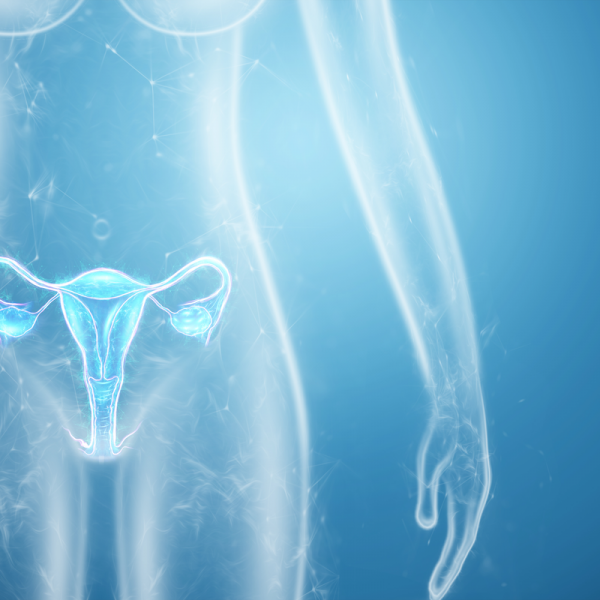
What is a fibromyoma?
A fibromyoma, or myoma, is a mixed tumour consisting of muscle cells (called myoma) and connective tissue. Fibromyomas usually take the form of uterine fibroids, which means they grow inside the uterus. A fibromyoma is a benign tumour that develops in an average of two out of five women and can occur singly (solitary fibroids) or in groups. Fibromyoma is one of the most common benign tumours in women, with an above-average number of overweight women between the ages of 30 and 40 developing fibromyoma. The tumours can vary greatly in size and be so small that they are hardly noticed, or they can develop an immense size that lines the entire uterus.
What causes a fibromyoma?
The exact causes of fibromyoma are still unknown. However, doctors believe that the likelihood of developing a fibromyoma increases with rising oestrogen levels. Therefore, a fibromyoma enlarges slowly during the period when the woman still has her period and shrinks after the menopause when the oestrogen level decreases.
In some cases, it is suspected that the occurrence of fibromyoma is hereditary. Chromosomal aberrations can often be detected in those at risk. In addition, fibroids have been found to occur more frequently in groups of African and African-American women than in groups of Caucasian women, for example.
What forms of fibromyoma are distinguished?
Depending on the location and the different layers of the uterus, fibromyoma can be classified as follows:
- intramural fibromyoma: refers to a fibromyoma that develops within the muscular walls of the uterus. An intramural fibromyoma can cause painful menstrual bleeding, but also discomfort when urinating (dysuria).
- intraligamentous fibromyoma: is a rather rare fibromyoma that can occur in the lateral connective tissue layers of the uterus. An intraligamentously growing fibromyoma can compress the ureters, leading to urinary retention and/or kidney disease.
- submucous fibroids: grow below the lining of the uterus. Submucosal fibromyomas can often cause increased menstrual bleeding.
- subserous fibromyomas: develop on the outside of the uterus and can grow large. In some cases, a pedunculated fibromyoma grows from the outer wall of the uterus and grows on a stalk. Because of the size of the subserous fibromyoma, it can put pressure on the bladder and/or bowel and therefore cause frequent urination or pressure pain in the lower abdomen.
- Cervical fibromyomas: occur in just under 8 per cent of all cases and grow within the muscles of the cervical area.A cervical fibromyoma causes compression of the cervical canal and puts pressure on nearby structures such as the bladder and rectum.
A fibromyoma is usually roundish and has smooth muscles.
What symptoms does a fibromyoma cause?
Fibromyoma does not usually cause any symptoms. However, in some cases, you may have heavier menstruation, abdominal pain, swelling in the abdomen, constipation or a frequent need to urinate. There may also be other possible symptoms:
- Pain or a feeling of pressure in the abdomen, which is mainly caused by large fibromyomas,
- A feeling of pressure on the bowels (constipation),
- Discomfort/pain during sexual intercourse (dyspareunia),
- Pain in the lower back and nerves, for example pain in the legs are possible due to the pressure of the tumour.
How does a fibromyoma behave during pregnancy?
If a fibromyoma is present at the time of pregnancy, there can be severe pain in the area of the fibromyoma, especially between the third and sixth month. In rare cases, a particularly large fibromyoma can be an obstacle to birth and a caesarean section may be necessary. The risk of miscarriage or premature birth is slightly increased in women with fibromyomas that grow in the uterus. In about 3 percent of all cases, a fibromyoma can be considered the main cause of infertility.
How is a fibromyoma diagnosed?
A fibromyoma is usually diagnosed by an ultrasound examination or other imaging techniques. As the tumour often does not cause any symptoms, it is usually detected during a routine examination.
How is fibromyoma treated?
Although fibromyoma is a benign tumour, the condition sometimes needs treatment, especially if the symptoms are severe. One form of treatment is medication to reduce the size of the tumour. For example, GnRHa or gonadotropin-releasing hormone agonist may be given to help shrink the tumour. However, the drugs can cause osteoporosis as a side effect and make the bones brittle, which is why the drugs should never be taken long-term.
In addition to treatment with drugs, the fibromyoma can also be reduced in size by the so-called UAE procedure or embolisation of the uterine arteries. This is done by cutting off the blood supply to the tumour.
Another option is surgery to remove the fibromyoma. This can be done during a hysterectomy, especially for large fibromyomas. In this procedure, the entire uterus is removed. In contrast, in a procedure called endometrial ablation, only the lining of the uterus and the fibroids near the surface of the uterus are removed. As an alternative to removing the uterus, a myomectomy can also be performed. This is an alternative method in which the fibroids are removed either through the cervix or through an incision in the uterus (possibly also using the so-called keyhole technique).
